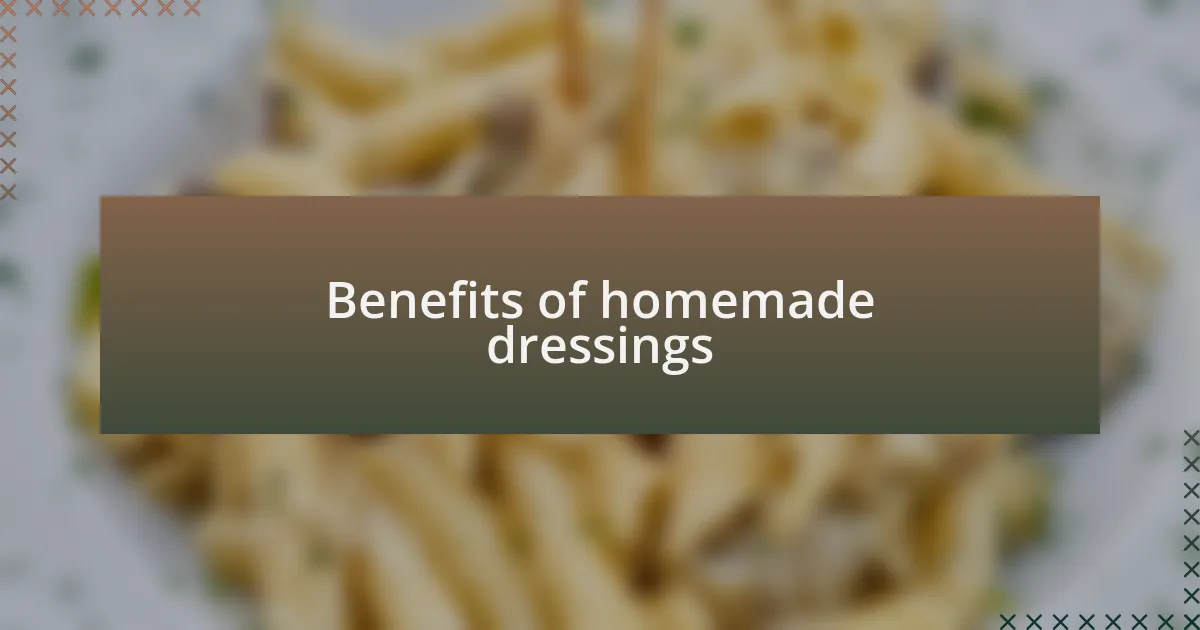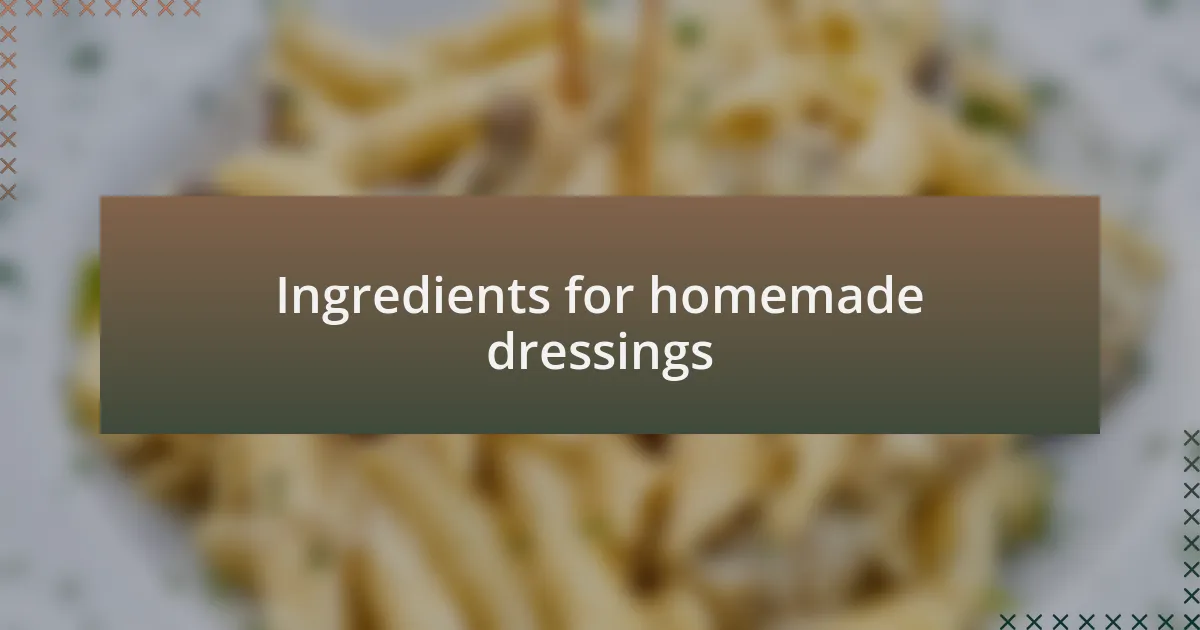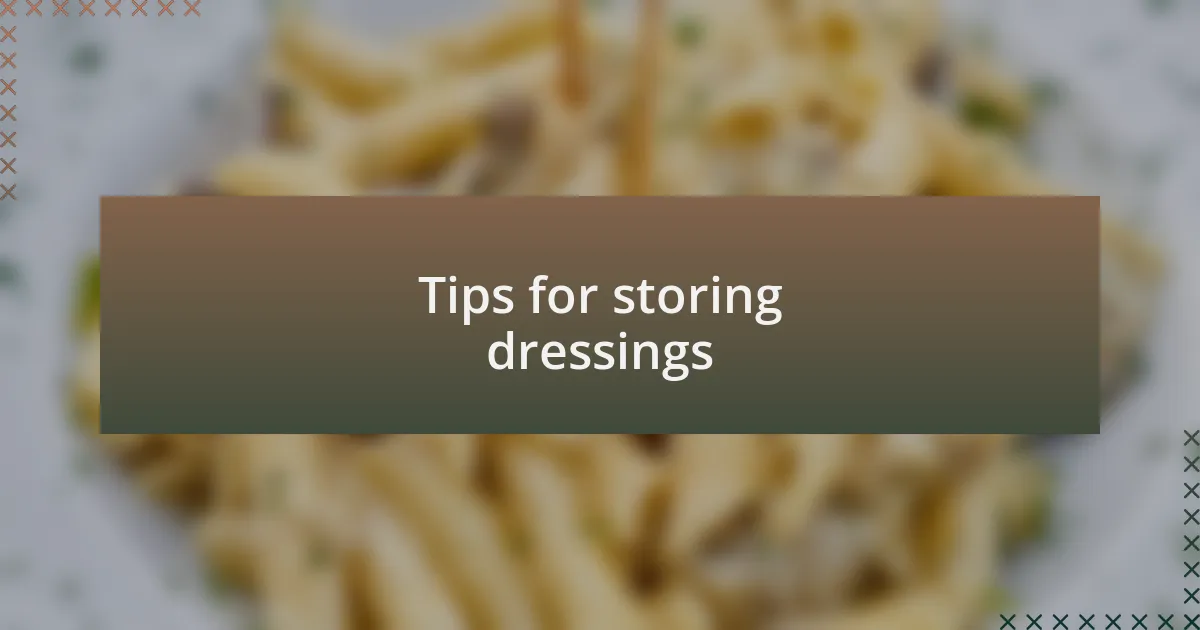Key takeaways:
- Healthy eating emphasizes balance and variety, focusing on nourishing foods that align with individual preferences and nutritional needs.
- Homemade dressings allow for control over ingredients, enhancing flavor freshness and adaptability to specific dietary requirements.
- Key ingredients for dressings include quality oils, fresh herbs, and a balance of acidity and sweetness.
- Storing dressings in airtight containers and labeling them with dates helps maintain freshness and quality for longer periods.

Healthy eating defined
Healthy eating is often about balance and variety. For me, this means filling my plate with colorful vegetables, whole grains, and lean proteins. I recall the first time I tried a vibrant quinoa salad; it opened my eyes to how nutritious food can also be beautiful and enjoyable.
What stands out to me about healthy eating is that it’s not just about restriction; it’s about celebrating nourishing foods that make us feel good. Every time I experiment in the kitchen, like blending fresh herbs into a dressing, I feel an emotional connection to what I eat. Isn’t it amazing how food can impact our mood and energy levels throughout the day?
Moreover, healthy eating is an individual journey. Each person has unique preferences and nutritional needs. I often think about how my childhood choices shaped my current habits—doesn’t that resonate with everyone at some level? It’s about finding what works best for you while aligning with broader concepts of wellness and vitality.

Benefits of homemade dressings
When I think about homemade dressings, I immediately appreciate the control I have over the ingredients. Every bottle I create becomes a canvas for my culinary creativity, allowing me to choose fresh, wholesome components without the preservatives and additives often found in store-bought versions. Have you ever read the label of a commercial dressing and felt overwhelmed by the unrecognizable ingredients? I have, and it made me long for something simpler and more natural.
Another benefit that stands out to me is the freshness of flavors. There’s nothing quite like the zing of a just-whisked vinaigrette, where the bright taste of lemon or the aromatic notes of fresh herbs awaken my dishes. I remember drizzling a homemade basil vinaigrette over grilled veggies once, and it transformed the meal into a vibrant explosion of taste. It’s this kind of freshness that simply can’t be matched by anything purchased off the shelf.
Moreover, homemade dressings can be tailored to fit almost any dietary need. Whether I’m watching my sodium intake or need to avoid certain allergens, I can easily adapt my recipes. For instance, when I discovered how to make a creamy dressing with avocado instead of mayonnaise, it opened a new world of creamy goodness without the guilt. Isn’t it empowering to whip up a dressing that fits my nutritional goals and still tastes divine?

Ingredients for homemade dressings
When I gather ingredients for my homemade dressings, I always start with the base. Common choices like olive oil, vinegar, or yogurt can set the stage for various flavor profiles. I love the richness of extra virgin olive oil; its smooth texture and robust flavor elevate even the simplest combination. Have you ever tasted the difference that quality oil can make?
Adding herbs and spices is where the magic happens. I often reach for fresh herbs from my garden, like basil or cilantro, because they infuse my dressings with vibrant freshness. Just recently, I made a cilantro-lime dressing that paired perfectly with my grilled chicken tacos. The aroma filled my kitchen, and it felt like a little celebration with each whisk. It’s fascinating how a handful of herbs can transform a standard dressing into something extraordinary.
Don’t underestimate the power of acidity and sweetness, either! A squeeze of lemon or a touch of honey can brighten a dressing and balance out flavors. I remember experimenting with a honey-mustard vinaigrette that was just the right mix of tangy and sweet. It not only complemented my green salads but also made a delightful dip for raw veggies. What are your favorite ingredients that make a dressing unforgettable?

Ways to customize dressings
The beauty of homemade dressings lies in their versatility, allowing you to play with flavors until you find the perfect blend. Recently, I decided to experiment by adding fruits to my vinaigrette. A splash of fresh orange juice combined with balsamic vinegar not only brightened the color but also added a sweetness that complemented my spinach salad beautifully. Have you ever tried incorporating fruit? It’s like a little burst of sunshine.
If you’re looking to enhance the creaminess of your dressings, consider adding nuts or seeds. I’ve fallen in love with tahini in my dressings lately—it adds a rich, nutty flavor that transforms a simple salad into a satisfying meal. Just last week, I whipped up a tahini-lemon dressing that worked wonders over roasted vegetables. It was a delightful surprise how these subtle changes can take your creations to a whole new level.
For a kick, I often incorporate different heat elements, be it a dash of hot sauce or finely chopped jalapeños. I recently added sriracha to a creamy dressing, and the result was a spicy blend I couldn’t get enough of. This balance of flavors not only tantalized my taste buds but also brought excitement to my meals. What flavors do you love to experiment with in your dressings?

My favorite dressing recipes
One of my all-time favorites is a classic lemon-dijon dressing. It’s simple yet so refreshing! I remember the first time I drizzled it over a mixed green salad—it completely transformed the dish. The tang of the lemon paired with the sharpness of the dijon created a zesty explosion that had everyone asking for the recipe.
Sometimes, when I feel a little adventurous, I whip up a chipotle ranch dressing. The smokiness of the chipotle elevates the creaminess, making it perfect for dipping veggies or drizzling on tacos. I vividly recall a game night when I served it alongside a platter of fresh veggies; the combination of flavors got everyone talking—and dipping—like there was no tomorrow.
Another gem in my collection is a honey-mustard vinaigrette. There’s something about the sweet and savory balance that captures my heart every time. I once used it as a marinade for chicken before grilling, and the outcome was blissful. The chicken was juicy and packed with flavor, leaving me wondering why I hadn’t created this dressing sooner. Have you discovered how a dressing can elevate not just salads but your entire meal?

Tips for storing dressings
When it comes to storing homemade dressings, one key tip I always follow is to use airtight containers. It’s amazing how a simple step can preserve freshness and flavors. I remember once making a large batch of my favorite balsamic vinaigrette, only to lose its vibrant taste after a few days because I didn’t seal it properly. It was a lesson learned—never underestimate the power of proper sealing!
For those dressings that contain dairy, like my zesty buttermilk ranch, refrigeration is crucial. I usually portion out what I’ll use in the next couple of days and store the rest in the back of the fridge, where it stays colder. It breaks my heart when I have to toss out a batch because it went bad too soon. Have you ever opened up your fridge only to find a forgotten dressing that’s passed its prime? It’s a real downer.
Lastly, I’ve found that labeling my dressings with the date made helps me keep track of their freshness. I once got caught off guard by a salad dressing that had been in the back of my fridge for too long—let’s just say the taste wasn’t what I remembered! Now, I make it a routine to jot down the date so I can enjoy every delicious drop while it’s at its prime. Do you have any tips for keeping track of your homemade creations?